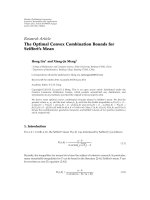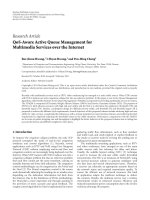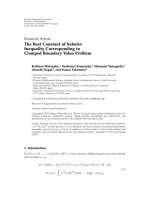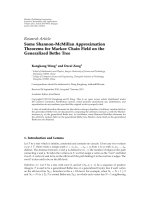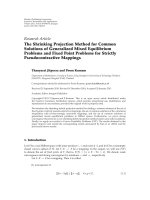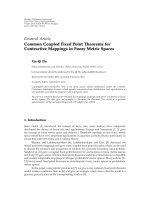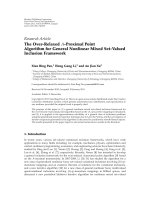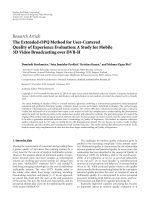Báo cáo hóa học: " Research Article The Over-Relaxed A-Proximal Point Algorithm for General Nonlinear Mixed Set-Valued Inclusion Framework" docx
Bạn đang xem bản rút gọn của tài liệu. Xem và tải ngay bản đầy đủ của tài liệu tại đây (505.16 KB, 12 trang )
Hindawi Publishing Corporation
Fixed Point Theory and Applications
Volume 2011, Article ID 840978, 12 pages
doi:10.1155/2011/840978
Research Article
The Over-Relaxed A-Proximal Point
Algorithm for General Nonlinear Mixed Set-Valued
Inclusion Framework
Xian Bing Pan,
1
HongGangLi,
2
and An Jian Xu
3
1
Yitong College, Chongqing University of Posts and Telecommunications, Chongqing 400065, China
2
Institute of Applied Mathematics Research, Chongqing University of Posts and Telecommunications,
Chongqing 400065, China
3
College of Mathematics and Statistics, Chongqing University of Technology, Chongqing 400054, China
Correspondence should be addressed to Xian Bing Pan,
Received 16 November 2010; Accepted 10 January 2011
Academic Editor: T. Benavides
Copyright q 2011 Xian Bing Pan et al. This is an open access article distributed under the Creative
Commons Attribution License, which permits unrestricted use, distribution, and reproduction in
any medium, provided the original work is properly cited.
The purpose of this paper is 1 a general nonlinear mixed set-valued inclusion framework for
the over-relaxed A-proximal point algorithm based on the A, η-accretive mapping is introduced,
and 2 it is applied to the approximation solvability of a general class of inclusions problems
using the generalized resolvent operator technique due to Lan-Cho-Verma, and the convergence of
iterative sequences generated by the algorithm is discussed in q-uniformly smooth Banach spaces.
The results presented in the paper improve and extend some known results in the literature.
1. Introduction
In recent years, various set-valued variational inclusion frameworks, which have wide
applications to many fields including, for example, mechanics, physics, optimization and
control, nonlinear programming, economics, and engineering sciences have been intensively
studied by Ding and Luo 1, Verma 2, Huang 3, Fang and Huang 4, Fang et al. 5,
Lan et al. 6, Zhang et al. 7, respectively. Recently, Verma 8 has intended to develop
a general inclusion framework for the over-relaxed A-proximal point algorithm 9 based
on the A-maximal monotonicity. In 2007-2008, Li 10, 11 has studied the algorithm for a
new class of generalized nonlinear fuzzy set-valued variational inclusions involving H, η-
monotone mappings and an existence theorem of solutions for the variational inclusions,
and a new iterative algorithm 12 for a new class of general nonlinear fuzzy mulitvalued
quasivariational inclusions involving G, η-monotone mappings in Hilbert spaces, and
discussed a new perturbed Ishikawa iterative algorithm for nonlinear mixed set-valued
2 Fixed Point Theory and Applications
quasivariational inclusions involving A, η-accretive mappings, the stability 13 and the
convergence of the iterative sequences in q-uniformly smooth Banach spaces by using the
resolvent operator technique due to Lan et al. 6.
Inspired and motivated by recent research work in this field, in this paper, a general
nonlinear mixed set-valued inclusion framework for the over-relaxed A-proximal point
algorithm based on the A, η-accretive mapping is introduced, which is applied to the
approximation solvability of a general class of inclusions problems by the generalized
resolvent operator technique, and the convergence of iterative sequences generated by
the algorithm is discussed in q-uniformly smooth Banach spaces. For more literature, we
recommend to the reader 1–17.
2. Preliminaries
Let X be a real Banach space with dual space X
∗
,andlet·, · be the dual pair between X
and X
∗
,let2
X
denote the family of all the nonempty subsets of X,andletCBX denote
the family of all nonempty closed bounded subsets of X. The generalized duality mapping
J
q
: X → 2
X
∗
is single-valued if X
∗
is strictly convex 14,orX is uniformly smooth space. In
what follows we always denote the single-valued generalized duality mapping by J
q
in real
uniformly smooth Banach space X unless otherwise stated. We consider the following general
nonlinear mixed set-valued inclusion problem with A, η-accretive mappings (GNMSVIP).
Finding x ∈ X such that
0 ∈ F
A
x
M
x
, 2.1
where A, F : X → X, η : X × X → X be single-valued mappings; M : X → 2
X
be an
A, η-accretive set-valued mapping. A special case of problem 2.1 is the following:
if X X
∗
is a Hilbert space, F 0 is the zero operator in X,andηx, yx − y,
then problem 2.1 becomes the inclusion problem 0 ∈ Mx with a A-maximal
monotone mapping M, which was studied by Verma 8.
Definition 2.1. Let X be a real Banach space with dual space X
∗
,andlet·, · be the dual pair
between X and X
∗
.LetA : X → X and η : X × X → X be single-valued mappings. A
set-valued mapping M : X → 2
X
is said to be
i r−strongly η-accretive, if there exists a constant r>0 such that
y
1
− y
2
,J
q
η
x
1
,x
2
≥ r
x
1
− x
2
q
, ∀y
i
∈ M
x
i
,i 1, 2; 2.2
ii m-relaxed η-accretive, if there exists a constant m>0 such that
y
1
− y
2
,J
q
η
x
1
,x
2
≥−m
x
1
− x
2
q
, ∀x
1
,x
2
∈ X, y
i
∈ M
x
i
,
i 1, 2
; 2.3
iii c-cocoercive, if there exists a constant c such that
y
1
− y
2
,J
q
η
x
1
,x
2
≥ c
y
1
− y
2
q
, ∀x
1
,x
2
∈ X, y
i
∈ M
x
i
,
i 1, 2
;
2.4
ivA, η-accretive, if M is m-relaxed η-accretive and RA ρMXX for every
ρ>0.
Fixed Point Theory and Applications 3
Based on the literature 6, we can define the resolvent operator R
A,η
ρ,M
as follows.
Definition 2.2. Let η : X × X → X be a single-valued mapping, A : X → X be a strictly
η-accretive single-valued mapping and M : X → 2
X
be an A, η-accretive set-valued
mapping. The resolvent operator R
A,η
ρ,M
: X → X is defined by
R
A,η
ρ,M
x
A ρM
−1
x
∀x ∈ X
,
2.5
where ρ>0 is a constant.
Remark 2.3. The A, η-accretive mappings are more general than H, η-monotone mappings
and m-accretive mappings in Banach space or Hilbert space, and the resolvent operators
associated with A, η-accretive mappings include as special cases the corresponding
resolvent operators associated with H, η-monotone operators, m-accretive mappings, A-
monotone operators, η-subdifferential operators 1–7, 11–13.
Lemma 2.4 see 6. Let η : X × X → X be τ-Lipschtiz continuous mapping, A : X → X be an
r-strongly η-accretive mapping, and M : X → 2
X
be an A, η-accretive set-valued mapping. Then
the generalized resolvent operator R
A,η
ρ,M
: X → X is τ
q−1
/r − mρ-Lipschitz continuous, that is,
R
A,η
ρ,M
x
− R
A,η
ρ,M
y
≤
τ
q−1
r − mρ
x − y
∀x, y ∈ X
,
2.6
where ρ ∈ 0,r/m.
In the study of characteristic inequalities in q-uniformly smooth Banach spaces, Xu
14 proved the following result.
Lemma 2.5. Let X be a real uniformly smooth Banach space. Then X is q-uniformly smooth if and
only if there exists a constant c
q
> 0 such that for all x, y ∈ X,
x y
q
≤
x
q
q
y, J
q
x
c
q
y
q
.
2.7
3. The Over-Relaxed A-Proximal Point Algorithm
This section deals with an introduction of a generalized version of the over-relaxed proximal
point algorithm and its applications to approximation solvability of the inclusion problem of
the form 2.1 based on the A, η-accretive set-valued mapping.
Let M : X → 2
X
be a set-valued mapping, the set {x, y : y ∈ Mx} be the graph
of M, which is denoted by M for simplicity, This is equivalent to stating that a mapping is
any subset M of X × X,andMx{y : x, y ∈ M}.IfM is single-valued, we shall still use
4 Fixed Point Theory and Applications
Mx to represent the unique y such that x, y ∈ M rather than the singleton set {y}.This
interpretation will depend greatly on the context. The inverse M
−1
of M is {y, x : x, y ∈
M}.
Definition 3.1. Let M : X → 2
X
be a set-valued mapping. The map M
−1
, the inverse of
M : X → 2
X
, is said to be general u, t-Lipschitz continuous at 0 if, and only if there exist
two constants u, t ≥ 0 for any w ∈ B
t
{w : w≤t, w ∈ X},asolutionx
∗
of the inclusion
0 ∈ Mxx
∗
∈ M
−1
0 exist and the x
∗
such that
x − x
∗
≤ u
w
∀x ∈ M
−1
w
, 3.1
holds.
Lemma 3.2. Let X be a q-uniformly smooth Banach space, η : X × X → X be a τ-Lipschtiz
continuous mapping, A : X → X be an r-strongly η-accretive mapping, F : X → X be a ξ-
Lipschtiz continuous mapping, and M : X → 2
X
be an A, η-accretive set-valued mapping. If
I
k
A − AR
A,η
ρ,M
A − ρFA, and for all x
1
,x
2
∈ X, ρ>0 and qγ > 1
A
x
1
− A
x
2
,J
q
A
R
A,η
ρ,M
A
x
1
− ρF
A
x
1
− A
R
A,η
ρ,M
A
x
2
− ρF
A
x
2
≥ γ
A
R
A,η
ρ,M
A
x
1
− ρF
A
x
1
− A
R
A,η
ρ,M
A
x
2
− ρF
A
x
2
q
,
3.2
then
qγ − 1
A
R
A,η
ρ,M
A
x
1
− ρF
A
x
1
− A
R
A,η
ρ,M
A
x
2
− ρF
A
x
2
q
I
k
x
1
− I
k
x
2
q
≤ c
q
Ax
1
− Ax
2
q
.
3.3
Proof. Let X be a q-uniformly smooth Banach space, η : X × X → X be a τ-Lipschtiz
continuous mapping, A : X → X be an r-strongly η-accretive mapping, and M : X → 2
X
be an A, η-accretive set-valued mapping. Let us set I
k
A − AR
A,η
ρ,M
A − ρFA and
s
i
Ax
i
− ρFAx
i
x
i
∈ X, i 1, 2, then by using Definition 2.2, Lemmas 2.4, 2.5,and
3.2, we can have
I
k
x
1
− I
k
x
2
q
Ax
1
− A
R
A,η
ρ,M
s
1
−
A
x
2
− A
R
A,η
ρ,M
s
2
q
Fixed Point Theory and Applications 5
≤ c
q
Ax
1
− Ax
2
q
− q
A
x
1
− A
x
2
,J
q
A
R
A,η
ρ,M
s
1
− A
R
A,η
ρ,M
s
2
A
R
A,η
ρ,M
A
x
1
− ρF
A
x
1
− A
R
A,η
ρ,M
A
x
2
− ρF
A
x
2
q
≤ c
q
Ax
1
− A
x
2
q
− qγ
A
R
A,η
ρ,M
A
x
1
− ρF
A
x
1
− A
R
A,η
ρ,M
A
x
2
− ρF
A
x
2
q
A
R
A,η
ρ,M
A
x
1
− ρF
A
x
1
− A
R
A,η
ρ,M
A
x
2
− ρF
A
x
2
q
≤ c
q
Ax
1
− Ax
2
q
−
qγ − 1
A
R
A,η
ρ,M
A
x
1
− ρF
A
x
1
− A
R
A,η
ρ,M
A
x
2
− ρF
A
x
2
q
.
3.4
Therefore, 3.3 holds.
Lemma 3.3. Let X be a q-uniformly smooth Banach space, η : X × X → X be a τ-Lipschtiz
continuous mapping, A : X → X be an r-strongly η-accretive and nonexpansive mapping,
F : X → X be an ξ-Lipschtiz continuous mapping, and I
k
A − AR
A,η
ρ,M
A − ρFA, and
M : X → 2
X
be an A, η-accretive set-valued mapping. Then the following statements are mutually
equivalent.
i An element x
∗
∈ X is a solution of problem 2.1.
ii For a x
∗
∈ X, such that
x
∗
R
A,η
ρ,M
A
x
∗
− ρF
A
x
∗
.
3.5
iii For a x
∗
∈ X, holds
I
k
x
∗
A
x
∗
− A
R
A,η
ρ,M
A
x
∗
− ρF
A
x
∗
0, 3.6
where ρ>0 is a constant.
Proof. This directly follows from definitions of R
A,η
ρ,Mx
and I
k
.
Lemma 3.4. Let X be a q-uniformly smooth Banach space, η : X × X → X be a τ-Lipschtiz
continuous mapping, A : X → X be an r-strongly η-accretive and nonexpansive mapping, F : X →
X be an ξ-Lipschtiz continuous and β-strongly η-accretive mapping, and I
k
A −AR
A,η
ρ,M
A − ρFA,
and M : X → 2
X
be an A, η-accretive set-valued mapping. If the following conditions holds
τ
q
q
1 c
q
ρ
q
ξ
q
− qρβ
<τ
r − mρ
1 c
q
ρ
q
ξ
q
>qρβ
,
3.7
6 Fixed Point Theory and Applications
where c
q
> 0 isthesameasinLemma 2.5, and ρ ∈ 0,r/m. Then the problem 2.1 has a solution
x
∗
∈ X.
Proof. Define N : X → X as follows:
N
x
R
A,η
ρ,M
A
x
− ρF
A
x
, ∀x ∈ X.
3.8
For elements x
1
,x
2
∈ X, if letting
s
i
A
x
i
− ρF
A
x
i
i 1, 2
, 3.9
then by 3.1 and 3.3, we have
N
x
1
− N
x
2
R
A,η
ρ,M
s
1
− R
A,η
ρ,M
s
2
≤
τ
q−1
r − mρ
A
x
1
− A
x
2
− ρ
F
A
x
1
− F
A
x
2
.
3.10
By using r-strongly η-accretive of A, β-strongly η-accretive of F,andLemma 2.5,weobtain
Ax
1
− Ax
2
− ρ
F
A
x
1
− F
A
x
2
q
≤
Ax
1
− A
x
2
q
c
q
ρ
q
FAx
1
− F
A
x
2
q
− qρ
F
A
x
1
− F
A
x
2
,J
q
A
x
1
− A
x
2
≤
1 c
q
ρ
q
ξ
q
− qρβ
Ax
1
− Ax
2
q
.
3.11
Combining 3.10-3.11, by using nonexpansivity of A, we have
N
x
1
− N
x
2
≤ θ
∗
x
1
− x
2
, 3.12
where
θ
∗
τ
q−1
r − mρ
q
1 c
q
ρ
q
ξ
q
− qρβ
1 c
q
ρ
q
ξ
q
>qρβ
.
3.13
It follows from 3.7–3.12 that N has a fixed point in X, that is, there exist a point x
∗
∈ X
such that x
∗
Nx
∗
,and
x
∗
N
x
∗
R
A,η
ρ,M
A
x
∗
− ρF
A
x
∗
.
3.14
This completes the proof.
Fixed Point Theory and Applications 7
Based on Lemma 3.3, we can develop a general over-relaxed A, η-proximal point
algorithm to approximating solution of problem 2.1 as follows.
Algorithm 3.5. Let X be a q-uniformly smooth Banach space, η : X × X → X be a τ-Lipschtiz
continuous mapping, A : X → X be an r-strongly η-accretive and nonexpansive mapping,
F : X → X be an β-strongly η-accretive mapping and ξ-Lipschitz continuous, and I
k
A − AR
A,η
ρ,M
A − ρFA,andM : X → 2
X
be an A, η-accretive set-valued mapping. Let
{a
n
}
∞
n0
a
n
≥ 1, {b
n
}
∞
n0
and {ρ
n
}
∞
n0
be three nonnegative sequences such that
∞
n1
b
n
< ∞,a lim sup
n →∞
a
n
≥ 1,ρ
n
↑ ρ ≤∞,
3.15
where ρ
n
, ρ ∈ 0,r/mn 0, 1, 2, ·, ·, · and each satisfies condition 3.7.
Step 1. For an arbitrarily chosen initial point x
0
∈ X,set
A
x
1
1 − a
0
A
x
0
a
0
y
0
, 3.16
where the y
0
satisfies
y
0
− A
R
A,η
ρ
0
,M
A
x
0
− ρ
0
F
A
x
0
≤ b
0
y
0
− A
x
0
. 3.17
Step 2. The sequence {x
n
} is generated by an iterative procedure
A
x
n1
1 − a
n
A
x
n
a
n
y
n
, 3.18
and y
n
satisfies
y
n
− A
R
A,η
ρ
n
,M
A
x
n
− ρ
n
F
A
x
n
≤ b
n
y
n
− A
x
n
, 3.19
where n 1, 2, ·, ·, ·.
Remark 3.6. For a suitable choice of the mappings A, η, F, M, I
k
, and space X, then the
Algorithm 3.5 can be degenerated to the hybrid proximal point algorithm 16, 17 and the
over-relaxed A-proximal point algorithm 8.
Theorem 3.7. Let X be a q-uniformly smooth Banach space. Let A, F : X → X and η : X × X → X
be single-valued mappings, and let M : X × X → 2
X
be a set-valued mapping and FA M
−1
be
the inverse mapping of the mapping FA M : X → 2
X
satisfying the following conditions:
i η : X × X → X is τ-Lipschtiz continuous;
ii A : X → X be an r-strongly η-accretive mapping and nonexpansive;
iii F : X → X be an ξ-Lipschtiz continuous and β-strongly η-accretive mapping;
iv M : X → 2
X
be an A, η-accretive set-valued mapping;
8 Fixed Point Theory and Applications
v the FA M
−1
be u, t-Lipschitz continuous at 0u ≥ 0;
vi {a
n
}
∞
n0
a
n
≥ 1, {b
n
}
∞
n0
and {ρ
n
}
∞
n0
be three nonnegative sequences such that
∞
n1
b
n
< ∞,a lim sup
n →∞
a
n
≥ 1,ρ
n
↑ ρ ≤∞,
3.20
where ρ
n
, ρ ∈ 0,r/mn 0, 1, 2, ·, ·, · and each satisfies condition 3.7,
vii let the sequence {x
n
} generated by the general over-relaxed A-proximal point algorithm
3.6 be bounded and x
∗
be a solution of problem 2.1, and the condition
A
x
n
− A
x
∗
,J
q
A
R
A,η
ρ,M
A
x
n
− ρF
A
x
n
− A
R
A,η
ρ,M
A
x
∗
− ρF
A
x
∗
≥ γ
A
R
A,η
ρ,M
A
x
n
− ρF
A
x
n
− A
R
A,η
ρ,M
A
x
∗
− ρF
A
x
∗
q
,
3.21
0 <c
q
a − 1
q
a
q
− q
a − 1
aγ
d
q
< 1, 3.22
hold. Then the sequence {x
n
} converges linearly to a solution x
∗
of problem 2.1 with
convergence rate ϑ,where
ϑ
q
c
q
a − 1
q
a
q
q
1 − a
aγ
d
q
,
a lim sup
n →∞
a
n
,d lim sup
n →∞
d
n
lim sup
n →∞
q
c
q
u
q
qγ − 1
r
q
u
q
ρ
q
n
,
∞
n1
b
n
< ∞.
3.23
Proof. Let the x
∗
be a solution of the Framework 2.1 for the conditions i–iv and
Lemma 3.4. Suppose that the sequence {x
n
} which generated by the hybrid proximal point
Algorithm 3.5 is bounded, from Lemma 3.4, we have
A
x
∗
1 − a
n
A
x
∗
a
n
A
R
A,η
ρ
n
,M
A
x
∗
− ρ
n
F
A
x
∗
. 3.24
We infer from Lemma 3.3 that any solution to 2.1 is a fixed point of R
A,η
ρ
n
,M
A − ρ
n
FA.First,
in the light of Lemma 3.2,weshow
R
A,η
ρ
n
,M
A
x
n
− ρ
n
F
A
x
n
− x
∗
≤ d
n
A
x
n
− A
x
∗
, 3.25
where d
n
q
c
q
u
q
/2γ − 1r
q
u
q
ρ
q
n
< 1andR
A,η
ρ
n
,M
Ax
∗
− ρ
n
FAx
∗
x
∗
.
Fixed Point Theory and Applications 9
For I
k
A − AR
A,η
ρ,M
A − ρ
n
FA, and under the assumptions including the condition
vii3.21, then I
k
x
n
→ 0n →∞ since the FAM
−1
is u, t-Lipschitz continuous at 0.
Indeed, it follows that R
A,η
ρ
n
,M
Ax
n
− ρ
n
FAx
n
∈ FA M
−1
ρ
−1
n
I
k
x
n
from ρ
−1
n
I
k
x
n
∈
FAMR
A,η
ρ
n
,M
Ax
n
−ρ
n
FAx
n
. Next, by using the condition iv and 3.1, and setting
w ρ
−1
n
I
k
x
n
and z R
A,η
ρ
n
,M
Ax
n
− ρ
n
FAx
n
, we have
R
A,η
ρ
n
,M
A
x
n
− ρ
n
F
A
x
n
− x
∗
≤ u
ρ
−1
n
I
k
x
n
, ∀n>n
. 3.26
Now applying Lemma 3.3,weget
R
A,η
ρ
n
,M
A
x
n
− ρ
n
F
A
x
n
− x
∗
q
≤
R
A,η
ρ
n
,M
A
x
n
− ρ
n
F
A
x
n
− R
A,η
ρ
n
,M
A
x
∗
− ρ
n
F
A
x
∗
q
≤ u
q
ρ
−1
n
I
k
x
n
− ρ
−1
n
I
k
x
∗
q
≤
u
ρ
n
q
I
k
x
n
− I
k
x
∗
q
≤
u
ρ
n
q
−
qγ − 1
r
q
R
A,η
ρ
n
,M
A
x
n
− ρ
n
F
A
x
n
− R
A,η
ρ
n
,M
A
x
∗
− ρ
n
F
A
x
∗
q
c
q
Ax
n
− Ax
∗
q
.
3.27
Therefore,
R
A,η
ρ
n
,M
A
x
n
− ρ
n
F
A
x
n
− x
∗
≤ d
n
A
x
n
− A
x
∗
, 3.28
where d
n
q
c
q
u
q
/2γ − 1r
q
u
q
ρ
q
n
< 1andR
A,η
ρ
n
,M
Ax
∗
− ρ
n
FAx
∗
x
∗
.
Next we start the main part of the proof by using the expression
A
z
n1
1 − a
n
A
x
n
a
n
A
R
A,η
ρ
n
,M
A
x
n
− ρ
n
F
A
x
n
, ∀n ≥ 0. 3.29
10 Fixed Point Theory and Applications
Let us set s
n
Ax
n
− ρ
n
FAx
n
and s
∗
Ax
∗
− ρ
n
FAx
∗
for simple. We begin with
estimating for a
n
≥ 1 and later using 3.2, the nonexpansivity of A, 3.21 and 3.28 as
follows:
Az
n1
− Ax
∗
q
≤
1 − a
n
A
x
n
a
n
A
R
A,η
ρ
n
,M
s
n
−
1 − a
n
A
x
∗
a
n
A
R
A,η
ρ
n
,M
s
∗
q
≤
1 − a
n
A
x
n
− A
x
∗
a
n
A
R
A,η
ρ
n
,M
s
n
− A
R
A,η
ρ
n
,M
s
∗
q
≤ c
q
1 − a
n
A
x
n
− A
x
∗
q
a
n
A
R
A,η
ρ
n
,M
s
n
− A
R
A,η
ρ
n
,M
s
∗
q
q
1 − a
n
a
n
A
x
n
− A
x
∗
,J
q
A
R
A,η
ρ
n
,M
s
n
− A
R
A,η
ρ
n
,M
s
∗
≤ c
q
a
n
− 1
q
Ax
n
− Ax
∗
q
a
q
n
R
A,η
ρ
n
,M
s
n
− R
A,η
ρ
n
,M
s
∗
q
q
1 − a
n
a
n
γ
R
A,η
ρ
n
,M
s
n
− R
A,η
ρ
n
,M
s
∗
q
≤ c
q
a
n
− 1
q
Ax
n
− Ax
∗
q
a
q
n
− q
1 − a
n
a
n
γ
R
A,η
ρ
n
,M
A
x
n
− ρ
n
F
A
x
n
− x
∗
q
≤
c
q
a
n
− 1
q
a
q
n
q
1 − a
n
a
n
γ
d
q
n
Ax
n
− Ax
∗
q
.
3.30
Thus, we have
Az
n1
− Ax
∗
q
≤ θ
n
Ax
n
− Ax
∗
q
, 3.31
where
θ
n
q
c
q
a
n
− 1
q
a
q
n
q
1 − a
n
a
n
γ
d
q
n
< 1,
3.32
and a
q
n
q1 − a
n
a
n
γ>0, a
n
≥ 1,
∞
n1
b
n
< ∞,andd
n
q
c
q
u
q
/2γ − 1r
q
u
q
ρ
q
n
< 1.
Since Ax
n1
1 − a
n
Ax
n
a
n
y
n
, we have Ax
n1
− Ax
n
a
n
y
n
− Ax
n
.It
follows that
A
x
n1
− A
z
n1
≤
1 − a
n
A
x
n
a
n
y
n
−
1 − a
n
A
x
n
a
n
R
A,η
ρ
n
,M
A
x
n
− ρ
n
F
A
x
n
≤ a
n
y
n
− R
A,η
ρ
n
,M
A
x
n
− ρ
n
F
A
x
n
≤ a
n
b
n
y
n
− A
x
n
.
3.33
Fixed Point Theory and Applications 11
Next, we can obtain
A
x
n1
− A
x
∗
≤
A
z
n1
− A
x
∗
A
x
n1
− A
z
n1
≤
A
z
n1
− A
x
∗
a
n
b
n
y
n
− A
x
n
≤
A
z
n1
− A
x
∗
b
n
A
x
n1
− A
x
n
≤
A
z
n1
− A
x
∗
b
n
A
x
n1
− A
x
∗
b
n
A
x
∗
− A
x
n
.
3.34
This implies from 3.38 and 3.39 that
A
x
n1
− A
x
∗
≤
θ
n
b
n
1 − b
n
A
x
n
− A
x
∗
.
3.35
Since A is an r-strongly η-accretive mapping and hence, Ax − Ay≥rx − y,this
implies from 3.35 that the sequence {x
n
} converges strongly to x
∗
for
θ
n
q
c
q
a
n
− 1
q
a
q
n
q
1 − a
n
a
n
γ
d
q
n
< 1,
3.36
where a
n
≥ 1,
∞
n1
b
n
< ∞,andd
n
q
c
q
u
q
/2γ − 1r
q
u
q
ρ
q
n
< 1.
Hence, we have
ϑ lim sup
n →∞
θ
n
b
n
1 − b
n
lim sup
n →∞
θ
n
q
c
q
a − 1
q
a
q
q
1 − a
aγ
d
q
.
3.37
By 3.22, it follows that 0 <ϑ<1 from the condition vi, and the sequence {x
n
} generated
by the hybrid proximal point Algorithm 3.5 converges linearly to a solution x
∗
of problem
2.1 with convergence rate ϑ. This completes the proof.
Corollary 3.8. Let X be a Hilbert space q 2,c
q
1, A : X → X be an r-strongly monotone
and nonexpansive mapping α 1, F 0 is a zero operator, M : X → 2
X
be an A-maximal set-
valued monotone. I
k
A −AR
A,η
ρ,M
A− ρ
n
FA, and the c ondition 3.21 hold, the M
−1
be u-Lipschitz
continuous at 0 u ≥ 0.Let{a
n
}
∞
n0
, {b
n
}
∞
n0
and {ρ
n
}
∞
n0
be the same as in Algorithm 3.5.If
0 < 1 − a
2
1 − γd
2
− a
1 −
2γ − 1
d
2
< 1, 3.38
then the bounded sequence {x
n
} generated by the general over-relaxed A-proximal point algorithm
converges linearly to a solution x
∗
of problem 2.1 with convergence rate ϑ,where
ϑ
1 − a
2
1 − γd
2
− a
1 −
2γ − 1
d
2
,
3.39
12 Fixed Point Theory and Applications
and d lim sup
n →∞
d
n
lim sup
n →∞
u
2
/2γ − 1r
2
u
2
ρ
2
n
u
2
/2γ − 1r
2
u
2
ρ
2
, a
lim sup
n →∞
a
n
,
∞
n1
b
n
< ∞.
This is Theorem 3.2 in 8,andif,inaddition,γ 1,A I then we can have the
Proposition 2 in 9.
References
1 X. P. Ding and C. L. Luo, “Perturbed proximal point algorithms for general quasi-variational-like
inclusions,” Journal of Computational and Applied Mathematics, vol. 113, no. 1-2, pp. 153–165, 2000.
2 R. U. Verma, “Approximation-solvability of a class of A-monotone variational inclusion problems,”
Journal KSIAM, vol. 8, no. 1, pp. 55–66, 2004.
3 N J. Huang, “Nonlinear implicit quasi-variational inclusions involving generalized m-accretive
mappings,” Archives of Inequalities and Applications, vol. 2, no. 4, pp. 413–425, 2004.
4 Y P. Fang and N J. Huang, “H-accretive operators and resolvent operator technique for solving
variational inclusions in Banach spaces,” Applied Mathematics Letters, vol. 17, no. 6, pp. 647–653, 2004.
5 Y P. Fang, N J. Huang, and H. B. Thompson, “A new system of variational inclusions with H, η-
monotone operators in Hilbert spaces,” Computers & Mathematics with Applications, vol. 49, no. 2-3, pp.
365–374, 2005.
6 H Y. Lan, Y. J. Cho, and R. U. Verma, “Nonlinear relaxed cocoercive variational inclusions involving
A, η-accretive mappings in Banach spaces,” Computers & Mathematics with Applications, vol. 51, no.
9-10, pp. 1529–1538, 2006.
7 Q B. Zhang, X P. Ding, and C Z. Cheng, “Resolvent operator technique for generalized implicit
variational-like inclusion in Banach space,” Journal of Mathematical Analysis and Applications, vol. 361,
no. 2, pp. 283–292, 2010.
8 R. U. Verma, “A general framework for the over-relaxed A-proximal point algorithm and applications
to inclusion problems,” Applied Mathematics Letters, vol. 22, no. 5, pp. 698–703, 2009.
9 T. Pennanen, “Local convergence of the proximal point algorithm and multiplier methods without
monotonicity,” Mathematics of Operations Research, vol. 27, no. 1, pp. 170–191, 2002.
10 H G. Li, “Iterative algorithm for a new class of generalized nonlinear fuzzy set-variational inclusions
involving H, η-monotone mappings,” Advances in Nonlinear Variational Inequalities, vol. 10, no. 1, pp.
89–100, 2007.
11 H. G. Li, “Approximate algorithm of solutions for general nonlinear fuzzy multivalued quasi-
variational inclusions with G, η-monotone mappings,” Nonlinear Functional Analysis and Applica-
tions
, vol. 13, no. 2, pp. 277–289, 2008.
12 H G. Li, “Perturbed Ishikawa iterative algorithm and stability for nonlinear mixed quasi-variational
inclusions involving A, η-accretive mappings,” Advances in Nonlinear Variational Inequalities, vol. 11,
no. 1, pp. 41–50, 2008.
13 H Y. Lan, “On multivalued nonlinear variational inclusion problems with A, η-accretive mappings
in Banach spaces,” Journal of Inequalities and Applications, vol. 2006, Article ID 59836, 12 pages, 2006.
14 H. K. Xu, “Inequalities in Banach spaces with applications,” Nonlinear Analysis: Theory, Methods &
Applications, vol. 16, no. 12, pp. 1127–1138, 1991.
15 X. Weng, “Fixed point iteration for local strictly pseudo-contractive mapping,” Proceedings of the
American Mathematical Society, vol. 113, no. 3, pp. 727–731, 1991.
16 R. U. Verma, “A hybrid proximal point algorithm based on the A, η-maximal monotonicity
framework,” Applied Mathematics Letters, vol. 21, no. 2, pp. 142–147, 2008.
17 H. G. Li, A. J. Xu, and M. M. Jin, “An Ishikawa-hybrid proximal point algorithm for nonlinear set-
valued inclusions problem based on A, η-accretive framework,” Fixed Point Theory and Applications,
vol. 2010, Article ID 501293, 12 pages, 2010.
